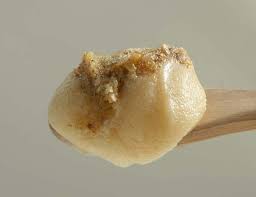Here are 5 sweetening options that are low to medium on the gylcemic index (GI). Several are allowed for diabetics and those on diets such as mine.
 Agave Nectar - GI 15-30
Agave Nectar - GI 15-30Also known as agave syrup. It is expressed from the agave plant and is a blend of fructose and glucose. Ratios vary from manufacturers so glycemic indexes do as well. Make sure your brand is relatively low in glucose, such as Wholesome Sweeteners Organic Blue Agave, and is minimally processed with heat.
Agave nectar is about 1.5 times sweeter than sugar and is a great substitution for natural and artificial syrups and processed honeys. Agave nectar dissolves quickly so works well when sweetening cold beverages such as tea or margaritas.
This sweetener is the new darling of food manufacturers. It is now an ingredient in soy yogurts, salad dressings and coconut milk ice creams. I try to keep in mind that the food industry likes to use the cheapest ingredients possible, so they are likely using higher levels of glucose in their products. It is better to buy a low glycemic nectar and add it to your plain yogurt or make your own frozen dessert.

Xylitol - GI 7-13
Xylitol is a sugar alcohol that naturally occurs in foods such as berries and corn husks as well as birch trees. It is safe for diabetes and hyperglycemia sufferers and pregnant or nursing moms. It is thought to prevent dental decay so is used in toothpastes and gums such as Trident. Studies suggest Xylitol may control oral candida and prevent the weakening of bones or progression of osteoporosis.
Some people can experience laxative or other intestinal issues with high sugar alcohol consumption.
Xylitol replaces sugar 1 to 1 with about 30% less calories. I use is as my sugar substitute in recipes. I also find xylitol packets convenient to carry in my purse.

Stevia - GI 0
Derived from the stevia plant, herb varieties can be up to 300 times as sweet as sugar. It hangs around a while and has what some people consider to be a strong aftertaste. It has zero calories.
Stevia was considered unsafe by the FDA as a food additive, although Japan consumes 40% of the stevia on the market. In 1995, stevia was approved as a diet supplement. Some studies suggest stevia is helpful in treating obesity, glucose tolerance and high blood pressure. Other reports show dangers related to male reproduction, cancer and energy metabolism.
Most recent brands, Pruvia for example, are blending stevia with sugar alcohols such as erythritol, making a better tasting sweetener. Like agave nectar, stevia is beginning to show up in commercial food products.

Coconut Sugar - GI 35
A recent arrival on the natural sweetener scene, this sugar is made from coconut palms. I found it first granulated but it is also available in a liquid. It reminds me of brown sugar and, having a high burn temperature, is good for baking. It is more nutritious than other sweetening options with traceable amounts of potassium and magnesium.

Raw Honey -GI 30
Processed honey has a glycemic index around 60, almost as high as table sugar. Eat raw honey and you reduce the glucose impact by 1/2 and it becomes low glycemic. Raw honey is honey that has not been heated or otherwise processed, leaving its vitamins and enzymes intact. Raw honey contains bits that make it more nutritious also, such as bee pollen, honeycomb and propolis.
Alkalizing benefits of raw honey include aiding in digestion and counteracting acid indigestion. Best of all, enzymes in raw honey help predigest starchy foods such as bread.
Other
Sugar Cane Juice - 43, Organic Sugar - 47, Black Strap Molasses 55, Table Sugar 65.
Glucose is 100. We should eat below 55. Brown Rice is 55. Rice Cake is 80.
Eventually, the goal would be to eliminate all sweetening additives from our diet. I am not there yet. With options such as agave nectar, raw honey and coconut sugar, I can be a bit indulgent without routinely my raising blood sugar levels into unhealthy and dangerous levels. Perhaps you can too.

No comments:
Post a Comment